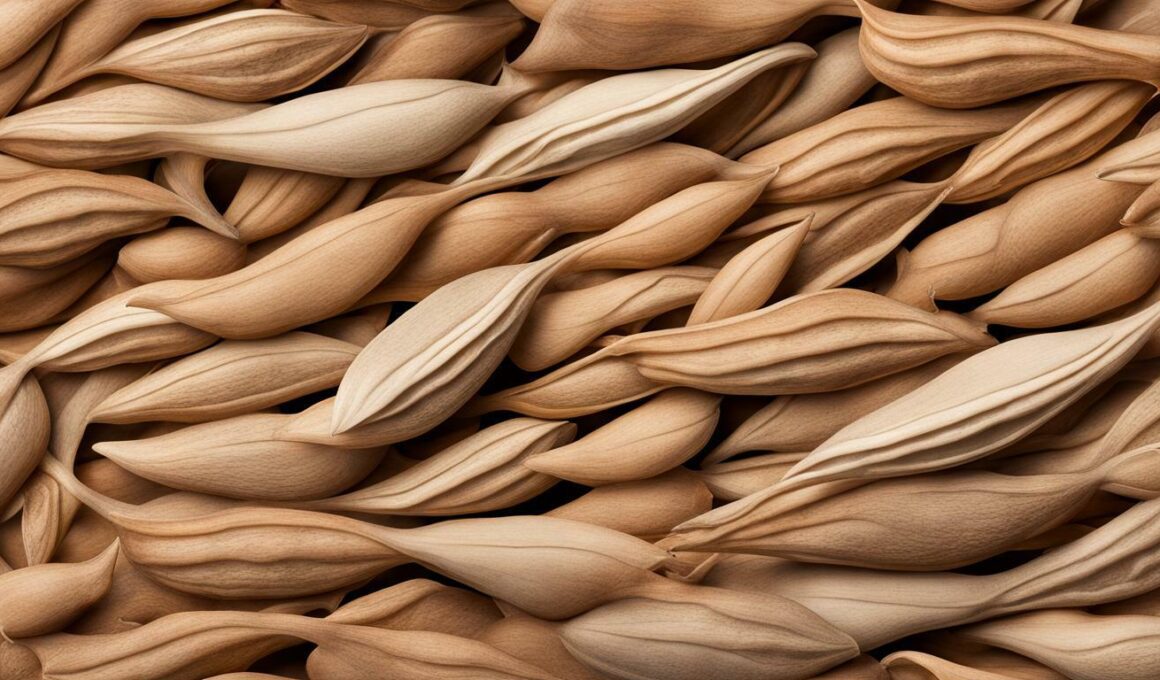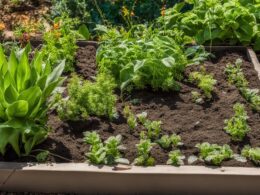If you’re interested in growing trumpet vines, it’s important to understand what their seeds look like and how to identify them. Not only will this knowledge help you successfully plant and grow these beautiful plants, but it will also help you avoid any confusion with similar-looking seeds. In this section, we’ll provide an overview of what a trumpet vine seed looks like and how to identify it.
Post Summary:- A trumpet vine seed is a key component of growing these plants successfully.
- Knowing how to identify trumpet vine seeds will make it easier to distinguish them from similar seeds.
- The appearance and characteristics of trumpet vine seeds will be discussed in detail in the following sections.
Characteristics of Trumpet Vine Seeds
Now that you know what a trumpet vine seed looks like, let’s dive into its unique characteristics. These seeds are oval or oblong in shape, and they can range in size from 1/4 to 1/2 inch long. The color of the seed coat can vary from light brown to dark brown, and the surface is typically smooth or slightly wrinkled.
One of the most distinctive features of a trumpet vine seed is its pointed tip, which is often pointed or curved. This unique shape makes it easy to identify these seeds from other types of vine seeds.
Additionally, trumpet vine seeds have a hard outer shell that can make them difficult to germinate. It’s important to scarify or carefully file the seed coat before planting to encourage successful growth.
Identifying Trumpet Vine Seeds
Now that you know what a trumpet vine seed looks like and its characteristics, it’s time to learn how to identify them.
The most distinctive feature of a trumpet vine seed is its shape. They are oblong with a pointy end and a flat end. The seed is also slightly curved, giving it a crescent-like appearance. The seed’s color is typically a light brown, and the shape and size are similar to a small pea or bean.
If you’re having trouble identifying the trumpet vine seed, you can compare it to pictures or images to confirm its appearance. Additionally, trumpet vine seeds can sometimes be found near the base of the plant or inside the trumpet-shaped flowers.
One important note to keep in mind when identifying trumpet vine seeds is that they can be mistaken for other types of seeds, such as beans or peas. Therefore, it’s important to pay attention to the specific shape and features of the seed to ensure it is a trumpet vine seed.
Images of Trumpet Vine Seeds
If you’re having trouble identifying trumpet vine seeds, take a look at these images for a better understanding of what they look like. The seeds are typically small, brown, and oval-shaped with a pointed end. They have a hard outer shell that helps protect the seed inside.
| Image | Description |
|---|---|
| This image shows a close-up of a trumpet vine seed, highlighting its distinct shape and color. | |
| This image provides a comparison of a trumpet vine seed to a dime, giving an idea of its small size. | |
| This image showcases a handful of trumpet vine seeds, displaying their unique appearance and texture. |
Remember, when planting trumpet vine seeds, it’s important to ensure they are properly identified to ensure optimal growth. Use these images as a reference to make sure you are planting the right seeds in the right way.
Planting Trumpet Vine Seeds
Planting trumpet vine seeds is a fun and rewarding experience that can result in a beautiful addition to your garden. However, to ensure that the seeds grow successfully, there are a few important tips to keep in mind.
Soil Preparation
The first step to successful planting is soil preparation. Trumpet vines prefer well-drained soil, so be sure to choose a location with good drainage. Additionally, you can add compost or other organic material to the soil to improve its fertility.
Planting Depth
The next important factor is planting depth. A good rule of thumb is to plant the seed at a depth that is roughly twice the size of the seed. For example, if the seed is 1/2 inch in size, plant it 1 inch deep.
Watering Techniques
Proper watering is also crucial for successful growth. Be sure to keep the soil moist, but not overly saturated, during the germination period. Once the plant begins to grow, you can gradually reduce the frequency of watering as the roots become more established.
Patience and Perseverance
Finally, it’s important to remember that growing trumpet vines from seeds can take some time and patience. It may take several weeks or even months before you begin to see visible growth. Don’t become discouraged if the seeds don’t sprout right away, as some varieties can take longer to germinate than others.
By following these tips and techniques, you should be well on your way to successfully planting and growing your own trumpet vine garden. Happy planting!
What Does A Trumpet Vine Seed Look Like and How Can I Start Growing It?
Starting trumpet vine from seed is a simple process that begins with acquiring the seeds. Trumpet vine seeds are elongated, brown capsules with a hard outer shell. To start growing it, soak the seeds in warm water for 24 hours before planting them in well-draining soil. Maintain moisture and warmth, and in no time, you’ll witness the sprouting of this vibrant vine.
Tips for Growing Trumpet Vine from Seeds
You’ve taken the first step in planting trumpet vines from seeds, but the journey isn’t over yet. Here are some additional tips and advice to ensure success:
- Choose the right location: Trumpet vines thrive in full sun, so make sure to plant them in a spot that gets at least six hours of direct sunlight per day. Additionally, consider the space where the vine will grow, as they can become quite large and require ample room to spread.
- Prune regularly: While trumpet vines don’t require much pruning, it’s important to keep them in check and prevent them from becoming too overgrown. Prune in the early spring before new growth begins and throughout the summer as needed to maintain shape and control growth.
- Provide support: As your trumpet vine grows, it will need support to climb and spread. You can use a trellis, fence, or other structure to provide support and promote healthy growth.
- Be patient: Trumpet vines can take several years to reach maturity and produce blooms, so don’t be discouraged if you don’t see blooms right away. With proper care and patience, your trumpet vine will eventually reward you with beautiful, vibrant flowers.
By following these tips, you’ll be well on your way to growing a beautiful and healthy trumpet vine from seeds. Happy planting!
Conclusion
Now that you know what a trumpet vine seed looks like and its unique characteristics, you can confidently identify them and start your own trumpet vine garden. Planting these seeds can be a fulfilling experience, especially when you see them grow and prosper.
Tips for Trumpet Vine Gardening
If you want to ensure successful planting and growth of your trumpet vine, it’s essential to follow some tips and tricks. First, make sure to prepare the soil well by removing any weeds and adding compost or fertilizer. Then, plant the seeds at a depth of 1 inch and water regularly.
It’s also essential to give the trumpet vine enough sunlight and prune it regularly to prevent overcrowding and promote new growth. Finally, watch out for any pests or diseases that can affect your plant and take necessary measures to prevent or treat them.
By following these tips and being patient, you can grow a beautiful and healthy trumpet vine from seed and enjoy its stunning flowers and lush foliage for years to come.
FAQ
Q: What does a trumpet vine seed look like?
A: A trumpet vine seed is small and oval-shaped, usually measuring about 1/4 inch in length. It has a hard outer shell and is typically dark brown or black in color.
Q: What are the characteristics of trumpet vine seeds?
A: Trumpet vine seeds are small, oval-shaped, and have a hard outer shell. They are typically dark brown or black in color and measure about 1/4 inch in length. Some may have a slightly lighter or mottled appearance.
Q: How can I identify trumpet vine seeds?
A: To identify trumpet vine seeds, look for small, oval-shaped seeds with a hard outer shell. They are usually dark brown or black in color. Additionally, trumpet vine seeds may have a slightly lighter or mottled appearance.
Q: Are there any images of trumpet vine seeds available?
A: Yes, we have included images of trumpet vine seeds below to help you visually identify them. Take a look:
Q: How do I plant trumpet vine seeds?
A: To plant trumpet vine seeds, start by preparing the soil in a sunny location. Dig a hole about 1 inch deep and place the seed inside. Cover it with soil and water gently. Maintain adequate moisture for successful germination.
Q: Any tips for growing trumpet vine from seeds?
A: Absolutely! Here are some tips for successful growth of trumpet vines from seeds: 1) Provide full sun for at least 6 hours a day. 2) Prune regularly to promote healthy growth. 3) Be mindful of potential challenges like pests or disease. With proper care, your trumpet vine should thrive!









